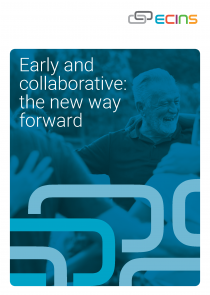By Sgt Julie Parsons, Manager ASB Unit & Rural Crime Team, Northamptonshire Police
Case Management and Meetings
We use ECINS for all ASB cases which meet the criteria for case management, starting mostly with Police Safer Community Teams. We have a specialist ASB Unit who take on referrals when the cases need the expertise. Many of our housing providers also use ECINS (for ASB, domestic abuse and hate crime, and can meet the Housemark requirements from it). This enables a real partnership response as we can all see what other departments are doing and share statements, plan joint visits, responses and action plans.
We used to meet on a weekly basis to discuss cases and share information, but now only meet monthly because we are all up to date on the cases through ECINS. We add photos from the Police custody system for offenders, but only add custody photos of victims if it is relevant to disclose that they have a history with the Police. Otherwise we leave it blank or take a photo with their consent. We have created our own risk assessment screening tools for victims and offenders, which ECINS added for us.
It’s an excellent system for partnership working on day-to-day case management.
Managing Street Community
We also use the “Street Community” gallery with street drinkers, rough sleepers, sex workers and beggars. We have partnership meetings to discuss this cohort and capture the information, action plans, housing and rehabilitation options offered and any offences committed and enforcement options used. Getting these partners on board using ECINS is still in progress, but having the Council outreach workers using it is definitely enabling a more joined up response to reduce rough sleeping. We have a number of third sector organisations using ECINS. One good tool we use with them is to have a ‘team’ for the paid staff of the charity, to whom we give access to the profile and case. They can then also allocate access to the individual volunteer involved with that case. This ensures that not all their volunteers have access to all of the profiles and cases.
In these areas of business, we create profiles for the perpetrators and the witnesses, and keep the profiles quite sparse. We add warning markers, contact details for key workers not on ECINS, carers, parents etc. … anything that would be useful for other professionals. Ideally, we use the Associates, Events tab and Prison tabs too. We use the “Wanted” markers and that has helped with the Outreach Workers identifying where one foreign national was sleeping rough and hiding from the Police.
Cases, Tasks, Actions and Reports
Other than those basics on the profiles, we use cases predominantly and have a case for ASB shared with the relevant partners. We use tasks, actions, logs and reports within cases and do not tick the actions so that they do not copy across to the profiles.
This means we can be confident that we have appropriately shared the information with the partners and don’t have to worry each time a new partner agency is allowed access to the profile. We use reports within cases to add confidential information for certain partners within that field, for example adding relevant Police intelligence just for Police colleagues, within the case.
Partners often create their own cases for specific work that they are doing with clients, such as rehabilitation interventions which the rest of us do not need to see.
We make good use of “umbrella” cases such as “Northampton Rough Sleepers” and have this case open during the multi-agency meeting. We then click on the case for each individual in the linked cases section.
Cross-county Management
ECINS is an excellent tool for various areas of business, and we are considering it for more and more. The common argument against it is that it involves double-keying, but it is such a user-friendly system that it is quick and easy to copy and paste. The fact that information is shared has reduced meeting times and reduced duplicated work. For example, we had a council receive complaints about a dog and they found on ECINS that the Police had started tackling the situation months before.
It definitely enables a better-informed and coordinated response for members of the community. We hope to continue to persuade more partners to join the party!

